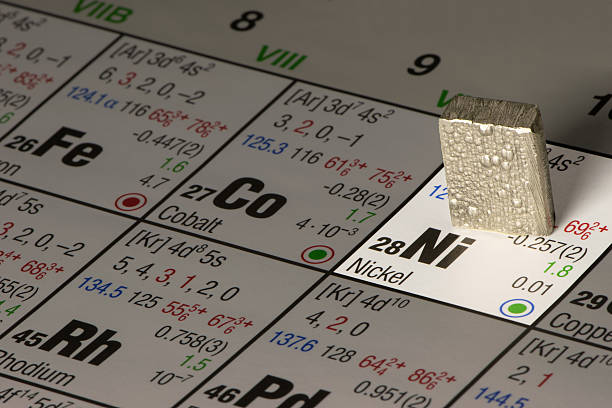Nickel

Parameter Type: Drinking Water Testing for Metals
Parameter Name: Nickel
What it is and Where it Comes From:
In its natural state, nickel is silvery, hard, and ductile. Nickel is in the Periodic Table with the symbol Ni and has an atomic number of 28. Pure nickel, powdered to maximize the reactive surface area, shows a significant chemical activity, but larger pieces are slow to react with air under standard conditions because an oxide layer forms on the surface and prevents further corrosion (passivation). Even so, pure native nickel is found in Earth’s crust only in tiny amounts, usually in ultramafic rocks, and in the interiors of larger nickel–iron meteorites that were not exposed to oxygen when outside Earth’s atmosphere. Nickel is used for mixing with other metals and plating. It is a very good conductor of heat and electricity. It is used in the manufacture of many alloys and products such as stainless steel, ceramic paint, jewelry, kitchen ware, batteries, textiles, and coins. Nickel is released into the environment by power plants, metal factories and waste incinerators. It is also used in fertilizers and enters groundwater from farm runoff. Nickel can be up 60% recyclable. The human body contains about 10 mg of Nickel. Drinking water testing gives you several benefits like peace of mind, identifying contaminants in your water, and insight into health concerns. Safe Home offers Laboratory drinking water testing kits for nickel, allowing you to collect your water sample and ship it directly to our EPA-Certified Laboratory. This platform of drinking water testing for nickel will give you an accurate level based on the lowest level of a parameter our instruments can detect (Method Detection Level). Safe Home drinking water testing for metals can be used for city and well water supplies. Drinking water testing should be done any time you notice a significant change in your water quality.
Health Effects:
Nickel is consumed in small amounts and found in multiple vitamins. It is used for increasing iron absorption, preventing anemia, and treating osteoporosis. Nickel is also used for making coins and weapons. High doses of Nickel can be very poisonous. Side effects from exposure include skin rash or allergic reactions. Those exposed for a long period of time can develop allergies, lung disorders, and cancer.
Solutions to Contaminant Levels:
After drinking water testing, what are my treatment options? The conventional methods which are commonly used for the removal of nickel from water are physico-chemical methods, such as chemical coagulation, chemical oxidation or reduction, active carbon adsorption, filtration, ion exchange and membrane technologies. Chemical coagulation is That process includes coagulation, a step in which chemicals are added that cause small particles suspended in the water to clump together. Chemicals (coagulants) are added to the water to bring the non-settling particles together into larger, heavier masses of solids called floc. Chemical oxidation is a process involving the transfer of electrons from an oxidizing reagent to the chemical species being oxidized. In water and wastewater engineering, chemical oxidation serves the purpose of converting putrescible pollutant substances to innocuous or stabilized products. Chemical oxidation processes take place in natural waters and serve as an important mechanism in the natural self-purification of surface waters. Carbon filtering is a method of filtering that uses a bed of activated carbon to remove impurities from a fluid using adsorption. Ion exchange usually describes a process of purification of aqueous solutions using solid polymeric ion exchange resin. Who do I need to contact to find out more information about water quality in my area? Every community water supplier must provide an annual report to its customers, known as a Consumer Confidence Report (CCR). The report provides information on your local drinking water quality, including the water’s source, contaminants found in the water, and how consumers can get involved in protecting drinking water. How often does the local public water system preform drinking water testing? Frequency of drinking water testing depends on the number of people served, the type of water source, and types of contaminants. Certain contaminants are tested more frequently than others, as established by the Safe Drinking Water Act. You can find out about levels of regulated contaminants in your treated water for the previous calendar year in your annual Consumer Confidence Report (CCR).
File Under: Metals
Drinking Water Testing - Parameter Types
Important Terms
-
MCL’s (Maximum Contaminant Levels) MCL’s are levels that set by the USEPA and are enforceable to Public Water Utilities, requiring additional treatment, when the levels are exceeded. These same guidelines should be at least considered, by owners of private wells. Some states have more strict guidelines than the USEPA. Not all parameters have MCL’s. If the parameter has an MCL, it’s listed.
-
MCLG’s (Maximum Contaminant Level Goals) MCLG’s are goals set by the USEPA that we should all strive for when consuming drinking water from any water supply. Concentrations of certain parameters (even below the MCL’s), are still not healthy for humans and animals to drink. These same guidelines should at least be be considered, by owners of private wells. Some states have more strict guidelines than the USEPA. Not all parameters have MCLG’s. If the parameter has an MCLG, it’s listed.
-
ACTION LEVELS ACTION LEVELS are a specified concentration of a respective parameter in drinking water, that is above a “treatment level” set by the USEPA. When these levels are exceeded, further treatment and monitoring is required by the respective utility who’s water violated this limit.Action Levels apply to parameter-rules such as but not limited to the Copper/Lead Rule.
-
PARTS PER MILLION (ppm) PPM is a scientific measurement which represents milligrams of the parameter being tested per liter of the respective liquid. Example: If Copper in your water supply is at a concentration of 1.00 mg/L, this is the same as saying the concentration is 1.00 ppm.


